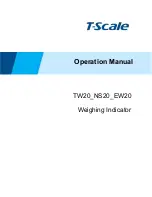
Basic Operation
"Dead" batteries
Connect battery
Program Sequence
PRIME and AUTO
If the battery to be serviced has no voltage reading, an
initial brief charge by a designated
charger is required.
The C4000 will not start the program if battery voltage is
not detected.
After selecting the program and target capacity, you are
now ready to connect the battery.
Battery connection
is
acknowledged
with a beep tone.
While the battery is
being serviced, the yellow RUN LED is on.
The program starts with discharge, followed by charge.
If the battery has no capacity (no energy), the program
starts with charge.
•
CHARGE
On the CHARGE program, the battery commences
with
charge.
No discharge is applied.
Method of battery
analysis
Definition of battery
capacity
It is not possible to obtain an immediate capacity
reading by inserting a battery.
The capacity is derived
by discharging
the battery at a calibrated current to the
end-of-discharge
threshold voltage.
The elapsed time
is measured and displayed as the derived battery
capacity.
When the batt-ery starts discharging,
the Global Display
reads "CAP:
0%".
The flashing capacity figure indicates
that the number is counting upwards.
When the battery
voltage has dropped to the end-of-discharge
threshold,
the discharge terminates.
The readings stop flashing
and the true capacity is then known.
Several capacity readings may be shown. If more than
five discharge-charge
cycles have been applied, the
2nd, 3rd, 4th and 5th readings indicate the latest four
capacities. The first reading (Residual Capacity)
remains visible at all times.
The capacity reading is the percentage
of the
manufacturer's
battery rating. The rating is measured
in
mAh (milliampere per hour).
For more information,
refer
to CHAPTER 11, "3. Battery Rating".
2-4
•
•
Summary of Contents for C4000 SERIES
Page 7: ...CHAPTER 1 CHAPTER 1 INTRODUCTION 1 1 INTRODUCTION...
Page 10: ...CHAPTER 2 BASIC OPERATION CHAPTER 2 BASIC OPERATION 2 1...
Page 16: ...CHAPTER 3 PROGRAMS TARGET CAPACITY CHAPTER 3 PROGRAMS TARGET CAPACITY 3 1...
Page 26: ...CHAPTER 4 STATUS INDICATORS CHAPTER 4 STATUS INDICATORS 4 1...
Page 36: ...CHAPTER 5 CHAPTER 5 FAULT CODES 5 1 FAULT CODES...
Page 48: ...CHAPTER 6 BATTERY ADAPTERS CHAPTER 6 BATTERY ADAPTERS 6 1...
Page 53: ...CHAPTER 7 PROGRAMMING BATTERY ADAPTERS CHAPTER 7 PROGRAMMING BATTERY ADAPTERS 7 1...
Page 64: ...CHAPTERS CHAPTER 8 UTiliTIES 8 1 UTiliTIES...
Page 72: ...CHAPTER 9 CUSTOM PROGRAMS CHAPTER 9 CUSTOM PROGRAMS 9 1...
Page 84: ...CHAPTER 10 CHAPTER 10 OPTIONS 10 1 OPTIONS...
Page 94: ...CHAPTER 11 CHAPTER 11 C CODE TABLES 11 1 C CODE TABLES...
Page 116: ...CHAPTER 12 CHAPTER 12 DIAGNOSTICS 12 1 DIAGNOSTICS...
Page 119: ...CHAPTER 13 CHAPTER 13 SERVICE 13 1 SERVICE...
Page 127: ...CHAPTER 14 SPECIFICATIONS CHAPTER 14 SPECIFICATIONS 14 1...
Page 131: ...APPENDIX A 1...
Page 146: ...GLOSSARY G 1 GLOSSARY...














































